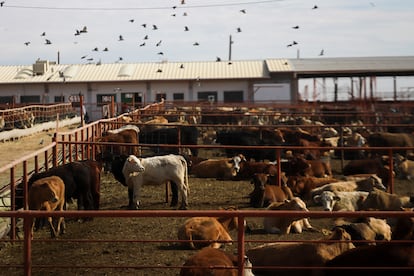Screwworm fly plague opens a new front between the Trump administration and Mexico
The US Secretary of Agriculture has warned that she will restrict livestock imports to the country if action is not taken to stop the infestation

The latest front in the dispute between the U.S. and Mexican governments is now being waged in the livestock sector. On Saturday, United States Secretary of Agriculture Brooke Rollins sent a letter to Claudia Sheinbaum’s administration warning that she will again restrict imports of animal products from Mexico if the fight against the Cochliomyia hominivorax, or screwworm fly, is not intensified by this Wednesday. The decision comes after several weeks of reported cases of this pest in states such as Tabasco and Chiapas, and just days before livestock imports into the United States were set to resume following an initial suspension, also due to screwworm, in November 2024.
Rollins posted the statement on her X account, in which she criticized Mexico for limiting fumigation flights to six days a week and singled out the country for imposing “onerous tariffs” on parts needed to maintain planes that have been responsible for part of the operation. “Mexico must eliminate restrictions on USDA [Department of Agriculture] aircraft and waive customs duties on eradication equipment. These barriers critically impair our joint response,” Rollins said. “Without resolution by April 30, USDA will close American ports of entry to cattle, bison, and equine from Mexico to protect U.S. agriculture.”
The response from her Mexican counterpart, Agriculture Secretary Julio Berdegué, came the following day, in a post on his X account, in which, without going into details, he said: “I have promptly responded to the letter from the United States Secretary of Agriculture, Brooke Rollins, on the issue of the cattle screwworm. As our President Claudia Sheinbaum has said, we act with a cool head, we coordinate, we collaborate, but we never subordinate ourselves.”
As the New World Screwworm outbreak is escalating, Mexico must eliminate restrictions on USDA aircraft and waive customs duties on eradication equipment. These barriers critically impair our joint response.
— Secretary Brooke Rollins (@SecRollins) April 26, 2025
Without resolution by April 30, @USDA will close American ports of entry… pic.twitter.com/SPeR5l3D7s
Until now, Mexico was one of the largest suppliers of livestock to the United States. According to data from the U.S. Department of Agriculture, 24,000 head of cattle were imported from Mexico in March, a significant drop compared to the 114,000 head imported for the same period in 2024. The decline in these figures peaked in November of last year, when a case of screwworm was identified in the city of Catazajá, in the state of Chiapas, leading to a temporary suspension of imports that had been ended the first week of February after joint protocols were agreed upon.
However, the identification of more cases in cattle in various parts of the country and the confirmation by the Ministry of Health, on April 17, of the first human case of screwworm myiasis made matters worse. The epidemiological notice published by Mexican authorities explained that the case involved a 77-year-old woman in the municipality of Acacoyagua, in Chiapas. Treatment generally involves surgical removal of the larva, followed by localized care to prevent infection.
In her press conference on Monday, President Sheinbaum supported Berdegué’s response and asserted that protocols to address the outbreak have been strengthened at the southern border and throughout the country. The president criticized the United States government for using Mexico as part of its campaigns ahead of the upcoming November elections in several states: “Mexico cannot be used as a piñata, as part of its campaign in a negative way,” she said.
Cochliomya hominivorax, the insect that causes the screwworm plague, is a parasite that feeds on the living tissue of any warm-blooded animal — including humans — although it primarily affects livestock. Upon contact with wounds, the larvae cause a parasitic disease called myiasis, which can be fatal and has caused millions in losses and threatens food security in several countries.

The main symptoms of the disease include fever, depression, and loss of appetite, associated with pre-existing skin wounds.
Although the nightmare of the screwworm was considered eliminated in Central America and Mexico in the late 1990s, illegal livestock farming and strong migratory flows have mobilized the pest once again, putting detection, control, and emergency systems to the test at the regional level.
Sign up for our weekly newsletter to get more English-language news coverage from EL PAÍS USA Edition
Tu suscripción se está usando en otro dispositivo
¿Quieres añadir otro usuario a tu suscripción?
Si continúas leyendo en este dispositivo, no se podrá leer en el otro.
FlechaTu suscripción se está usando en otro dispositivo y solo puedes acceder a EL PAÍS desde un dispositivo a la vez.
Si quieres compartir tu cuenta, cambia tu suscripción a la modalidad Premium, así podrás añadir otro usuario. Cada uno accederá con su propia cuenta de email, lo que os permitirá personalizar vuestra experiencia en EL PAÍS.
¿Tienes una suscripción de empresa? Accede aquí para contratar más cuentas.
En el caso de no saber quién está usando tu cuenta, te recomendamos cambiar tu contraseña aquí.
Si decides continuar compartiendo tu cuenta, este mensaje se mostrará en tu dispositivo y en el de la otra persona que está usando tu cuenta de forma indefinida, afectando a tu experiencia de lectura. Puedes consultar aquí los términos y condiciones de la suscripción digital.
More information
Archived In
Últimas noticias
‘How does it feel to be a failure?’: Elizabeth Berkley’s journey from ‘Showgirls’ ridicule to vindication
The story of the Málaga virus: The code that haunted Google’s cybersecurity center director for 30 years
The impact of Ecuador’s mega-prison: A polluted river, cleared forests and military checkpoints
Corinne Low: ‘I’m more concerned about the female happiness gap than the gender wage gap’
Most viewed
- The low-cost creative revolution: How technology is making art accessible to everyone
- Christian Louboutin: ‘Young people don’t want to be like their parents. And if their parents wear sneakers, they’re going to look for something else’
- All the effects of gentrification in one corner of Mexico’s Colonia Roma
- Liset Menéndez de la Prida, neuroscientist: ‘It’s not normal to constantly seek pleasure; it’s important to be bored, to be calm’
- Christmas loses its festive spirit: ICE fears cast shadow over religious celebrations










































